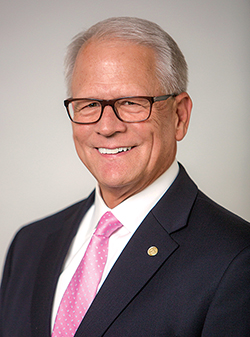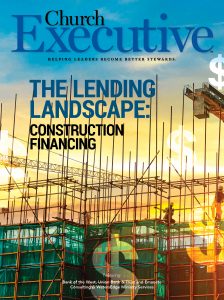
 A long-time church lending expert talks about how churches navigated COVID-era financing challenges — and the lessons they’ll carry forward.
A long-time church lending expert talks about how churches navigated COVID-era financing challenges — and the lessons they’ll carry forward.

President & Chief Lending Officer
WatersEdge Ministry Services
Tell me about WatersEdge and your history with the company.
Jerry Vaughan: WatersEdge Ministry Services (formerly The Baptist Foundation of Oklahoma) has been making loans to churches since 1953. Personally, I’ve been here almost 21 years and came from a banking background, spending almost 20 years as a lender. I was also on staff as a church administrator in North Carolina for about four years.
In my time here at WatersEdge, we’ve expanded our operation from making loans to only Oklahoma churches, to issuing loans in 22 states.
One of our main strengths is our ability to keep the process fairly simple. While we prioritize due diligence, of course, we don’t have the same regulatory pressures as banks do. What we bring to the table is a streamlined process. We try to move from application to closing as quickly as we can.
Another thing that makes us unique is that the interest a church pays on a loan through WatersEdge is returned to other churches and ministries through our investment program. We’re a nonprofit.
And we don’t take deposits from individuals; it’s all from churches and like-minded, not-for-profit ministries.
Can you compare 2021 to 2020 in terms of construction financing?
Vaughan: A lot of churches put their projects on hold in 2020 or decided not to move forward with projects they’d been considering. One big reason is because the cost of building skyrocketed. Several churches I work with had already closed on their loans but hadn’t started construction; they went back to re-cost or resize their projects. A church here in Oklahoma saw an almost 200-percent increase in its project cost! Another church — this one in Virginia — came to me a few weeks ago and said, “We’ve refigured the project cost, and we’re going to need to borrow another $1 million.” Fortunately, we were able to accommodate this need and keep the church’s project moving forward.
And the costs just keep going up.
Additionally, delivery delays are happening on a wide scale. Several churches I’m working with have decided on metal buildings, but they’re looking at eight- to nine-month delivery delays. That’s unusual.
Likewise, how does 2021 construction financing landscape compare to pre-pandemic?

Vaughan: There’s just no comparison. For us, 2019 was a fairly active year in terms of churches expanding their ministries.
Now, as I mentioned, a lot of the churches who paused their projects in 2020 are reengaging and starting back up with their planning. I think people are coming back on campus, and churches are beginning to feel the need for new, expanded space.
The applications I started getting in March seem to be fairly similar to what I was getting in 2019 before COVID hit.
Have any trends emerged related to the kinds of facilities churches are building now?
Vaughan: So many churches have gone back to reimagine how they use their space. For example, they’re considering bigger, multifunctional rooms.
But I also get the sense that things are pretty much returning to normal in churches. There are still some facility-use questions, but a lot of the unknowns surround the new normal in churches — what that’s going to be.
I recently talked to a pastor in Colorado who said that 30 percent of his church’s attendance is still online. And I keep hearing that about one-third of people will never come back to physical worship; another one-third will come back; and the other one-third is still deciding what to do.
Do you expect any pandemic-centric construction financing “trends” to carry forward?
Vaughan: Yes; the focus on technology.
In my experience, a lot of the churches that had streaming capabilities and online giving in place pre-pandemic didn’t miss a beat. In fact, many of those church leaders have told me that their giving only declined slightly, if at all, during COVID.
On the other hand, I’ve heard of churches where deacons went door-to-door to get contributions because they didn’t have an online giving platform in place.
Are there any lessons learned related to pandemic-era church lending that are important for churches to be aware of in the future?
Vaughan: Mostly that they need to be prepared for unexpected situations that impact the church directly. You need to be able to react. So, staying connected to your church — other than just in-person meetings — is going to be important.
I also think churches will need to decide at some point how best to conduct small groups. Even at my small group that I attend and teach, we’re continuing to offer a Zoom alternative.
I think what you’re saying is important, because if a church does these things — and sustains engagement as a result — maybe it won’t need to suspend their building projects the next time disruption strikes?
Vaughan: Right. But frankly, I think we were all surprised that church giving didn’t take an across-the-board hit. That’s a testimony to the faithfulness of many Christians.
As a church lender, I can tell you that we weren’t sure how churches would be impacted when the pandemic initially hit. As we progressed through 2020 — April, May, June, July — we were still unsure.
Then, starting around last August, I began to see loan applications pick up again.
I think COVID has been a big lesson in adaptability. A church needs to be nimble and flexible.
But they also need lenders who are adaptable, who can move with them. That’s one of the benefits of having a ministry-related financing partner like WatersEdge: we understand what’s going on in churches and make provisions for that.
— Reporting by RaeAnn Slaybaugh


